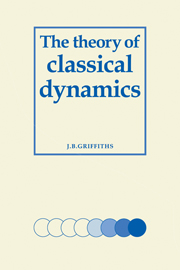Book contents
- Frontmatter
- Contents
- Prefaces
- Introduction
- 1 The Newtonian method
- 2 Space, time and vector notation
- 3 Force, mass and the law of motion
- 4 Newtonian relativity
- 5 Newtonian gravitation
- 6 Particle dynamics
- 7 Systems of several particles
- 8 Rigid body dynamics
- 9 Analytical dynamics
- 10 Variational principles
- 11 Hamilton–Jacobi theory
- Appendix list of basic results and definitions
- Suggestions for further reading
- Index
Introduction
Published online by Cambridge University Press: 25 October 2011
- Frontmatter
- Contents
- Prefaces
- Introduction
- 1 The Newtonian method
- 2 Space, time and vector notation
- 3 Force, mass and the law of motion
- 4 Newtonian relativity
- 5 Newtonian gravitation
- 6 Particle dynamics
- 7 Systems of several particles
- 8 Rigid body dynamics
- 9 Analytical dynamics
- 10 Variational principles
- 11 Hamilton–Jacobi theory
- Appendix list of basic results and definitions
- Suggestions for further reading
- Index
Summary
The classical theory of dynamics is that scientific theory which was developed through the seventeenth, eighteenth and nineteenth centuries to describe the motion of physical bodies. The theory was originally developed in two distinct parts, one dealing with terrestrial bodies such as a projectile or a pendulum, and the other dealing with celestial bodies, in particular the planets. These two apparently distinct subjects were first brought together by Isaac Newton whose book, known as the Principia, is rightly acknowledged as the first complete formulation of the theory that is now referred to as classical dynamics.
Since those early days the theory has been thoroughly developed and extended so that it can now be applied to a very wide range of physical situations. Some of the early concepts have been clarified, and others have been added. But, although the theory has now been formulated in many different ways, it is still essentially the same as that originally proposed by Newton. The most significant advances have in fact been those associated with the development of new mathematical techniques, which have subsequently enabled the theory to be applied to situations which previously had proved too difficult to analyse.
Now, as is well known, a revolution occurred in scientific thinking in the first part of the present century. Classical theories were disproved, and exciting new theories were put forward. The theory of relativity was suggested in order to explain the results obtained when the speed of light was measured.
- Type
- Chapter
- Information
- The Theory of Classical Dynamics , pp. xi - xivPublisher: Cambridge University PressPrint publication year: 1985



